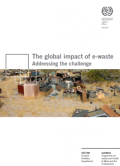
Going Green at the Grassroots narrates how the Inter-American Development Bank (IDB), in partnership with Nordic Development Fund (NDF), is working with companies across Latin America and the Caribbean to harness the enormous potential of energy efficiency and small-scale renewable energy. The IDB has conducted more than 30 energy efficiency audits and feasibility studies across a range of sectors, from shrimp farming to clothing manufacturing to dairy operations. Energy engineering specialists perform energy audits, self-supply renewable energy assessments, financial feasibility studies and develop project design plans in Central America. This case study illustrates how a private sector initiative is gaining steam in Central America and demonstrating, company by company, the feasibility and appeal of renewable energy.
This manual provides guidance on how to use indicators in designing and implementing green economy policies at the national level. It seeks to support interested countries to use indicators as a tool for identifying priority issues, formulating and assessing green economy policy options, and evaluating the performance of policy implementation. Emphasis is placed on those policy options with “multiple dividends” across the environmental, social and economic dimensions of sustainable development.
This study offers a critical review of the strengths and weaknesses of various methodologies, and of the adequacy of models to help countries to assess their economies and develop green economy strategies. This report, however, does not identify the best approaches for formulating and evaluating green economy strategies; instead, it provides key information for the ministries tasked with planning and implementing responsibilities to evaluate the adequacy of various models in meeting their specific needs.
The key message emerging from the study is that Green Economy can be an effective tool in transitioning Egypt into a sustainable development path that can address the main challenges facing the country. This publication is supplemented with a document showcasing successful existing green initiatives in Egypt. The Green Economy: Egypt Success Stories highlights local ventures, cleaner production centres, financial assistance programmes and entrepreneurial projects that are successful in generating economic, social and environmental benefits. It aims to inform policy makers and businessmen about the financial and economic viability of green investments and business.
